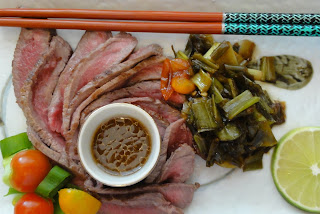Larisa’s Not Negimaki serves 6 normal dinner appetites
One of the side effects
of being a foodie who worked in restaurants twenty plus years ago – coupled,
perhaps with a mix of nostalgia and memory loss, is that sometimes recipes get
embellished in my mind almost beyond recognition. Sometimes the embellished version tastes better,
even if it doesn’t look as pretty when I make it.
I worked in the upstairs dining room of a Washington, D.C. sushi bar when I was a young, flamboyant thing. The kitchen staff seared very tender cuts of beef and sent it in slabs to the the sushi chefs, who sliced it as thin as if it were one of their papery radish garnishes. We served the beef on big platters, individually rolled like roses
with scallions and drizzled with a sauce made of mirin, shoyu, sake and a bit
of ginger. Occasionally a diner unrolled a "maki" and discovered to his or her horror that it was "too long" to eat gracefully without a knife. Instead of getting a knife, I would cut the strips smaller at their table by manipulating two pairs of chopsticks at once, one in each hand - no knives. (The trick is to pierce the meat with the points of a pair of skinny chopsticks closed together, then push them open at once. People actually started requesting this silly little feat!) The meat in the picture above was sliced rather thickly with a Santoku knife and is a rather ordinary cut of beef; I couldn't possibly cut it neatly with chopsticks.
I haven’t eaten this
particular dish in a restaurant since probably 1984 or 1985, but I’ve thought of it several
times recently, adding a few ingredients and changing the preparation in my
mind each time.
Not Negimaki Ingredients
3 lbs beef, without gristle. Tri-tip would be great.
Peanut oil for two cast
iron skillets
Marinade
2 tbsp. sesame oil
2 tbsp. shoyu or tamari
2 tbsp. mirin
2 tbsp. light vinegar –
rice or coconut would be best.
1 tbsp. shiro miso (shiro means white, but it is a light mustard color)
1/3 c. dry sake. Try to get a reasonably good brand. If you have to make do with
Sho Chiku Bai, make sure you get extra dry.
Sho Chiku Bai, make sure you get extra dry.
Juice of ½ lime
Greens from 2 bunches
scallions, sliced.
12-16 cherry
tomatoes, sliced in half
Method
Mix all liquid
ingredients until smooth. Heat empty
cast iron skillets several minutes on medium high to high heat, until it is
smoking hot, then add enough oil to coat bottom and split 3 lb. steak between
the two skillets. Sear on each side –
just long enough to make a good crust, about 2 minutes on each side. Do not leave long enough to cook
through. Steak should be very rare
inside but have some crunch at the edges.
Remove from heat and let cool before slicing against the grain into very
thin slices. If you have a good knife, you can slice it thinly enough to roll it up with scallions in the middle like the original negi
[scallion] maki [hand roll].) Pour most of the marinade (reserving 1/3 cup)
and half the scallions and cherry tomatoes into one skillet. Cook, stirring, until reduced by half and vegetables
are wilted. Arrange beef on a
platter. Pour reduced sauce over
top. Arrange fresh vegetables around
edges for color. Serve with some fresh
sauce for dipping.
Enjoy!
Enjoy!


